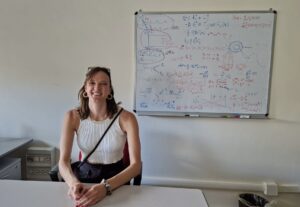Master’s student in theoretical physics Eva Groenendijk of Nikhef and the University of Amsterdam spent over two months in Rome on a work grant for her research. She writes a weekly weblog about her experiences and her research work. Part 11, final post: goodbye’s are not my thing.
Dear readers, my very last blog about Rome, which I am writing from the train back to the Netherlands. I will be on that for another twenty hours or so, so I have plenty of time to write about this last week in Rome.
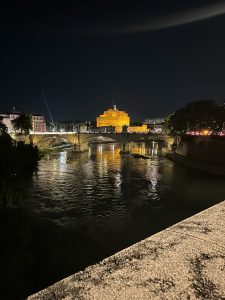
My first goodbye was to some Italian friends last weekend. For the occasion, a group of us went to a small concert on a grassy field that had been converted into an open-air pub. The performers were a group of Italians from the south. ‘We don’t know how to have fun, in southern Italy they do,’ my friend Lorenzo pressed me. The band made a specific kind of southern music, to which a group of people danced in the middle of the lawn. And these people could actually dance! I loved it, I had never seen anything like it before so I found myself in constant fascination. I do classical ballet myself, but am now thinking about making a switch. Maybe the southern Italians still need someone for their dance company.
Second, I said goodbye to Marco. He had to be in Genoa all week from Tuesday, so on Monday I saw him for the last time. We immediately had three long meetings, as we did want to make good use of this last day and finish the last things we could. Didn’t work out, by the way. But we tried! Afterwards, I thanked Marco extensively for the past few months, which was certainly justified. The time he put into teaching me the small-x resummation subject, the hospitality at INFN and simply working together on this project have made this internship more than worthwhile. I have learnt an awful lot here!
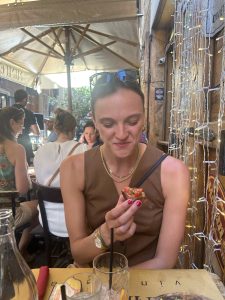
All in all, these were really fun months in Rome! In physics, of course, but also apart from that. Highlights for me were things like the SM@LHC conference, the South Italian concert, many evenings in Trastevere, and the opportunity to work on a new project in a new environment. The latter was incredibly valuable for me, as I suddenly got all new inspiration outside my normal bubble, and also because I was able to work closely with Marco. This made me feel like I was really doing something relevant, which made it a lot of fun. I also found out that I really do find QCD very interesting, and during my stay here I learned a lot about it. Through the PhD course I did, but also just by working on it in the project and talking about it with Marco. Fortunately, I’m sure I can learn more about QCD in the Netherlands.
And so now on my way back to the rain! I’ve heard that people in the Netherlands haven’t seen the sun for a few weeks, so I’m definitely looking forward to that. Don’t worry, I’ll bring back some Italian sunshine.
Greetings,
Eva
June 7: Finally visiting Fermi.
Dear readers, Near the Spanish Steps, on a rooftop terrace above the Corso, you can eat three pillows of ravioli for twenty euros. I found that out last weekend when I had a fancy dinner out. But we did get a discount on the wine and the place was beautiful, you could look out over the whole neighbourhood. And I was glad to have an excuse to put on one of the pretty dresses I took to Rome. So all in all, a pleasant experience.
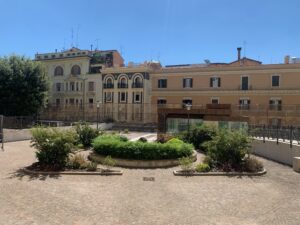
The waiter brought our drinks and bowls of cocktail nuts to the makeshift seat we had chosen: the kerb. Again, I thought that was a funny experience – I have trouble imagining a Dutch waiter who would allow glassware on the street, let alone one who would go through his knees with a tray full of wine glasses to put them in front of us.
Furthermore, after the rather physicist blogs of the past few weeks, this time I wanted to tell about a trip I took. A physics outing, by the way. Can you remember that a few blogs ago I walked along the Via Panisperna and found nothing there?
Following that blog, I got a tip from Paul de Jong (thanks for that!), who told me that there is another entrance that does lead to the old physics institute. There is even a whole museum now set up about Enrico Fermi and his ‘Ragazzi di Via Panisperna’. Of course I had to go there! The only problem, however, was that the Italian Ministry of Internal Affairs is built around the museum, so you can’t get in without making an official appointment. Nicely convenient.
The website indicated that there would be an open day at the end of June, but I would be in the Netherlands by then. So I sent an e-mail to the secretariat along the lines of ‘I am a physics student from the Netherlands, I am doing research on particles, Enrico Fermi is my big hero, may I please … ‘. I got a response to that, against my expectations, within an hour. There was someone who could show me around on Wednesday morning, was that convenient? It was convenient.
So I went to the Ministry of Internal Affairs last Wednesday. There I was searched at the entrance, had to hand in my ID card and a policeman took me through the courtyard to the museum. There was only no one in the museum. Incidentally, the policeman turned out to know a thing or two about the history of the building, so I stood and chatted with him until 15 minutes later a boy about my age came running in panting. ‘Sorry I’m late! I’m here to show you the museum.’
Francesco turned out to be a Material Science student whose side job was giving groups of high school students tours of the epic discoveries made in this building. He had read my email and apparently volunteered to give me a private tour, which I thought was very nice. What I most enjoyed seeing was the famous fountain in which Fermi and co conducted their experiment with delayed neutrons (see photo).
In this experiment, the neutrons were slowed down by shooting them through the water of the fountain. Apart from being a home for goldfish, the fountain thus became the first step towards nuclear fission with slow neutrons. Multifunctional thing.
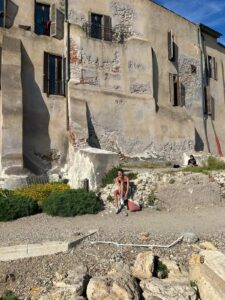
The ‘Fermiac’ was meant to model the behaviour of neutrons from an initial distribution. It was one of the first Monte Carlo’s! All in all, the museum was definitely worth a visit, just for the whole experience around it. If you are still looking for a nice place for a conference, I heard from Marco that they still take place there from time to time.
And so in the afternoon I went back to work on the Monte Carlo we use, keeping in mind that they did the same thing here in Rome a little less than a hundred years ago.
1 June: Just a bit technical
Dear Readers, This week started well on Monday morning, with an INFN seminar on heavy-flavor production in colliders. The talk was quite QCD-filled and quite technical, but to my own surprise I was able to follow it from start to finish! Surely I appear to have learned a thing or two last year.
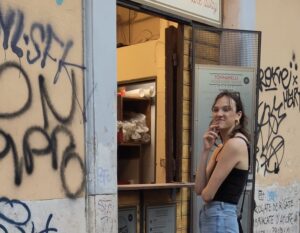
I think I mentioned something about this last week, but Marco created UGDs that we can use in a Monte Carlo event generator that also does small-x resummation. A UGD is an “unintegrated” PDF that contains the “normal” PDF (PDF is a particle distribution function, the distribution of quarks in a particle like for instance the proton).
The difference is that the UGD does not depend on the on-shell energy scale of the process – like a normal PDF, but on an off-shell transverse momentum kT. This is where the principle of kT factorization comes in: the factorization of the cross section in coefficient functions with off-shell momenta (kT), and the UGDs with that same off-shell momenta.
This in itself is somewhat similar to the collinear factorization between normal PDFs and on-shell coefficient functions, with the major difference being that the momenta of the hard matrix element in kT factorization are off-shell, and that we also have to integrate over this off-shell-ness.
Well, complicated story, bottom line is that Marco and I want a Monte Carlo simulation that asks for UGDs as input instead of normal PDFs, and that uses a hard matrix element with off-shell momenta instead of the on-shell matrix element. And it also needs to do that extra integration, of course. The kT factorization formula, of course, is not at all the same as the normal (collinear) factorization formula, but in form they are quite similar.
And that’s what the Monte Carlo we’ve been using so far, KaTie, uses (this event generator I don’t think will be named after its creator’s daughter). KaTie uses those off-shell coefficient functions, and the UGD for the input Marco creates with his code HELL.
HELL provides so-called evolution functions. You can convolute these evolution functions with a normal PDF to eventually arrive at a UGD. Of course, it is a bit more complicated, but – long story short – the idea is to evolve the PDF from the energy scale of the PDF (i.e., from the collinear factorization) to the off-shell energy scale (kT). Between those two energy scales the radiative corrections that result in small-x logarithms happen, so the UGDs contain the small-x resummation.
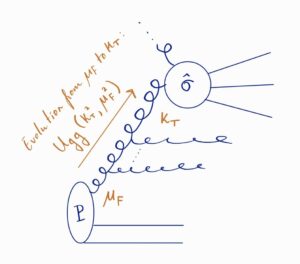
I am now working on predictions for the bottom, and then I will look at charm production, which is our ultimate goal. It all seems to be going well so far, so I hope to have the first results for charm next week.
So I did a lot of studying last week, of course also for the deep inelastic scattering project, which we are pretty much wrapping up now. In addition, I found out that all my friends actually started writing their thesis months ago, so that was also a (somewhat stressful) kick in the butt to actually put something on paper.
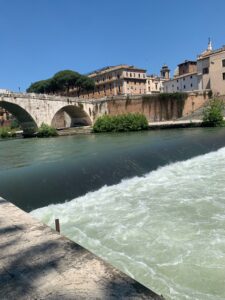
What was study-able this week is that last weekend I rather banged my ankle while running for the last streetcar home. So I can’t play tennis, run or take long walks, which means fewer distractions!
But I have been doing other fun things too, don’t worry. The beach, eating out, reading on the balcony, there’s still plenty to do. See you next week!
May 24: Starting my thesis
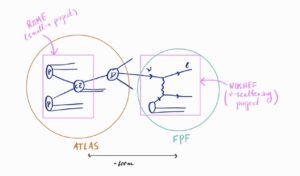
Rather, I am daily doing calculations for specific processes, programming within one of the thousand scripts that comprise the simulation, or typing “qsub run-parallel.sh” into the linux terminal. Small links of the big process, in other words. But it is fun and important to occasionally look at the forest in addition to the trees. I thought I’d take you through that this week.
You see, the two projects I’m working on, one in Rome and the other at Nikhef, are both relevant to the same topic: the long journey from the proton-proton collision at ATLAS to the FPF detectors. This is quite literally a long process; there is no less than half a kilometer between ATLAS and the FPF, and a lot happens during this process. Let’s look at charm production.
At ATLAS, charm quarks are produced, which hadronize into a particle moving in the forward direction. This particle then decays into a neutrino, and this neutrino can be detected 600 meters away in a deep inelastic scattering experiment at the FPF. In the Nikhef theory group we are, as I hope you learned, modeling this deep inelastic scattering: the last link of the process.
For this we use already modeled neutrino fluxes as input. But then again, our pursuits only make sense if we also have accurate predictions for the neutrino fluxes. So the whole fuss actually starts with the proton-proton collision.
And that in turn is what my project in Rome is about: the very first link. A lot of effort has already been put by other people into predictions for the neutrino fluxes coming from ATLAS. This uses POWHEG (hadron-hadron) to model charm production from proton-proton collisions, then a parton shower, and then other things I don’t know much about for the decay to neutrinos (for the interested reader, see ). And voila, neutrino fluxes.
What Marco and I are now exploring is whether it is necessary to do small-x resummation when modeling the charm production that underlies the flux predictions. So this project is about the very first part of the process, and my Nikhef project is about the last part. And to think that in the meantime there are all kinds of things happening in the meantime, too.
I actually also wanted to go into more detail about exactly what Marco and I are doing to put small-x resummation into event generation. Only this has suddenly become a very long story, so I’ll save that for next week! So apparently I am quite long-winded, I apologize in advance to the people who are going to review my thesis. Bottom line, I continue to think it’s cool that we can mimic such long trajectories with theoretical physics. Cool right, that we can cause processes with experimental methods and then describe them theoretically? Humans can actually do quite a lot.
Aside from musings on the social engineering of the world, I’ve made myself useful this week, by the way. A lot of typing in the linux terminal! With the result that I now have both the first pages of my thesis and the first results that can be included.
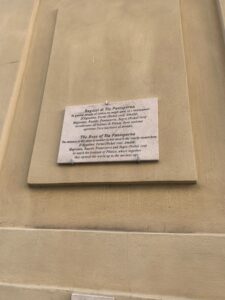
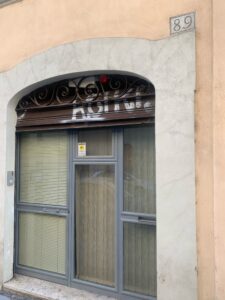
May 18: In Italy longer
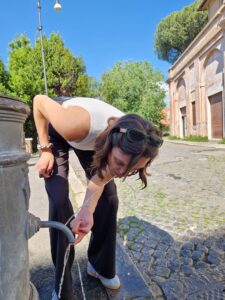
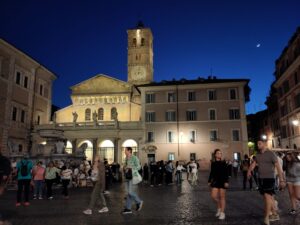
Now my father is a very stubborn man who definitely knew which way to go. Came to a point where we were standing on the side of a major highway consulting google maps. As we stood there arguing, a police car approached us from behind, with the siren and that spinning light on top. Oh dear.
Out of the car stepped a policeman in full uniform – I personally find the uniforms of the. ‘Carabinieri’ very stylish. He quietly left the siren on while leaving his car in the middle of the road, looked at me and said “can I help you? Then he showed us the way to the Via Appia and made all the traffic on the road stop so we could cross. I have not
felt like such a tourist in Rome before.
I also have a new roommate, Jonas, with whom I get along very well. He is from Heidelberg and is here for a surgery internship. Tuesday night the two of us went out to dinner in Trastevere. So he is German, and possesses that punctuality that is also deep in Dutch culture. Very pleasant, we had agreed to leave at 7:30, and we actually got out the door at 7:30!
During dinner he told me a few things about the hospital where he is doing his internship. Apparently the Pope has a private wing in this hospital that is always kept free in case he gets sick.
By the way, Jonas hasn’t started at the hospital yet because a wide range of health tests and bureaucratic procedures must first be completed. This has been going on for a week and a half now. Complicated procedures and incomprehensible documents seem to be something you just have to get used to when you are in Italy.
I found that out when I tried to find out this week if I could apply for a PhD in Italy. After all, I really like it here, so it certainly doesn’t seem like a punishment to spend three years in Rome or somewhere else in Italy in the future.
Marco had urged me that I would have to start working soon, because now is the time when applications open. So I hit the Internet in high spirits, thinking I would see a great job opening somewhere, send in my resume and motivation, and then hear back.
That turned out to be an illusion. I got completely lost in a spider web of websites that all point to the next website, where you have to click through endlessly again, only to end up downloading five different PDFs that can only be found in Italian. But maybe it’s just me. This weekend I’m going to make a second attempt, and this time I’m bringing reinforcement in the form of an Italian friend who can help translate.
Since I like it here so much, I have also decided to stay a little longer than initially planned. Marco only likes it if I stay a little longer, and Juan said that he doesn’t really care where I am physically; that I should do my work where I have the best inspiration. So I can postpone my return trip for two weeks! After that, though, I really have to go back to Holland.
I’ve heard that when summer starts, Rome is not the place to be in terms of temperature and air quality. I think those two extra weeks are just what I need to finish my little-x project, and I’ll still be back in Amsterdam in time to be able to write my thesis at my leisure (I say now).
And besides the things I can still do in college, I also feel like exploring cultural Rome some more. Last week I went with a new friend to some kind of storytelling night at some cultural center. You could put your name in a big hat and when it was pulled out, you had to tell a five-minute story.
In a very fun and informal way, it allowed people to express their creativity, and have a wine and chat in the breaks. Very cozy! Also, I am going to the museum night in Rome tonight, so you will hear about that next week!”
May 10: Visitors
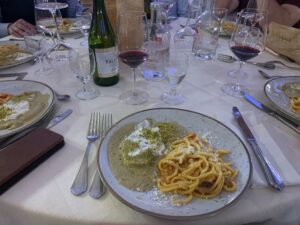
I thought it was a bit too much to attend all the talks all week, so I chose to go to at least all the QCD sessions and some of the Higgs talks. At the beginning of the week, I had pizza with Melissa and she gave me some tips on which parts were interesting to me.
I based the schedule a bit on that. The sessions were a nice combination of theory and experimentation, both of which interest me, so I heard plenty of new things and wrote my notebook full of them. The (rather broad) topic that has particularly stuck is the calculation of multi-loop scattering amplitudes in QCD with multiple massive internal lines.
There was a lot of talk about that on Thursday afternoon and the methods people had come up with for it sounded fascinating. I was glad I had brought my notebook, because I am very bad at remembering things like this without writing them down.
What I am also very bad at is doing several things at once. This resulted in me bumping into an open door yesterday morning, looking at my phone and searching for my keys while walking to my office. The corridor was full of students who had a good laugh at this, and I was limping for the rest of the day because I had hit my knee really hard.
In the afternoon, I attended the SM@LHC talk, and after the final presentation we all made our way to the restaurant where the social dinner was to take place. This restaurant was on the other side of town near Campo de’ Fiori, where I went with a group via a tourist route on foot.
Knee-wise that might not have been very convenient, but we did get a very nice guided tour from one of the Italian organisers. I have a lot of respect for the fact that this man guided about 15 people through the centre of Rome without losing any of them.
The dinner itself took place in a large, high back room of the restaurant and was hearty fun. The acoustics left a bit to be desired, but that also gave the place character. After a starter and a reasonable plate of pasta, we were all very satisfied, but the only Italian man sitting at our table told us that this was just the beginning. We all looked at him with a little smile, like ‘yeah yeah, right.’
But he was right, there was another whole course to come, plus dessert. In the end, that was very cosy, because it meant we could have a nice long dinner and there was plenty to talk about. For instance, I learned that while digging for the CMS experiment, they came across a complete Roman villa, including pottery and coins. It will happen to you!
Apparently, this is quite a problem here in Rome too. Any construction project one wants to set up, be it a metro line or an apartment complex, is bound to be delayed because there are always Roman remains in the ground somewhere.
By the way, besides the conference, I did a lot of other things this week. We are making pleasant progress on our neutrino project. This week we were (finally) able to benchmark our results with Pythia and with calculated cross sections, which means that my nice plots now have nice content too! Very nice. Now we can get on with actually using the event generator and NLO predictions for FASER are starting to come into view.
With my small-x project, I am also starting to get somewhere. I have now created differential distributions for the situation without small-x resummation, and Marco is creating unintegrated PDFs in a format that I can use to create distributions for the situation with resummation. If all goes well, we can with those ingredients already make our first ready-made predictions for the effect of small-x resummation. But of course, it never works like that, there are bound to be some problems involved.
So this week was fairly physics-filled, but I also did other things. I played tennis (lost this time), watched Real Madrid against Bayern, had aperitifs in Trastevere. Also, my parents are now in Rome for a weekend, so I will entertain them in the coming days. Plenty to do!
Part 5: Art and plots.
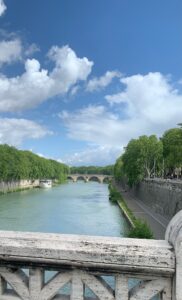
Last Wednesday on May 1 was Workers’ Day, which is a day off here when small festivals are organized. I had asked my Italian friends if they had plans to go to such an event. They replied that they made plans every year but then stood outside every year in the rain and cold, so they would rather not have that experience this year. At the time I asked the question, it was 30 degrees, so I didn’t believe any of it. But they were right.
Fortunately, despite the weather, it was a fun and productive week. A highlight of the weekend was a trip to the Galleria Nazionale d’Arte Moderna with my Dutch friends. The reason we went here was actually because the Villa Borghese was already sold out and this museum was next door, but it turned out to be a good (and cheaper) choice. I really like modern art, and one of my friends also paints himself, so we ended up spending the whole afternoon taking in the gigantic permanent exhibition they have there. Definitely recommended if you are ever in Rome!
Speaking of art, I made some very nice plots this week. Only the results in them are not so nice yet. Some strange things happen when comparing our results with cross sections I calculated analytically. But at least now you can clearly see that something goes wrong because I plotted it so nicely, so that’s the positive side. In addition, my Monte Carlo PhD course started the tutorial part, on MC@NLO. I had, I must admit, never heard of that before I started this PhD course, but it is nice to learn about a new Monte Carlo. The same goes for the event generator that Marco and I plan to use to resummarize charm production.
I find it quite difficult each time to start working with a new code, but when it finally succeeds it feels really good. I am now in the process of trying to compare the events produced by KaTie with the events coming out of POWHEG. It’s all a bit slow, it’s proving quite difficult to be working on two projects at the same time! In terms of managing time, switching between thought processes, etc. My tactic now is to switch between the two projects by getting coffee in between and not thinking about anything for a while. That works pretty well.
I also had lunch in Sapienza’s large cafeteria for the first time. My tennis friend had brought me along, and we had a full five-course meal for the money you get two coffees for in Holland. And it was delicious, too. By the way, my tennis friend also studies physics, and he took it upon himself to show me the nicest spots in the Marconi Building. The Marconi Building is one of two physics buildings at Sapienza, and to me it is a maze with unexpected corridors, shortcuts and hidden balconies everywhere.
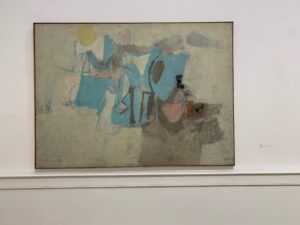
April 30: Birthday and Liberation Day.
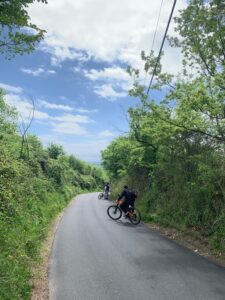
All in all, a successful birthday, which ended with eating a “pinse” at a little restaurant across the street. A pinse is actually exactly the same as a pizza, but in an elliptical shape. Even the Italians said they wouldn’t taste the difference. Apparently, twenty years ago someone used just slightly different dough for a pizza, called it a pinse and then marketed it as if it were a traditional Roman dish.
The Romans do have a knack for that, saying things are a thousand years older than they actually are – I learned from my archaeology friends.
So now in Italy it’s a long weekend from Thursday to Sunday, which gives me plenty of time to show my Dutch friends Rome, and in the meantime, well, study. Marco and I are exploring whether we can use an existing event generator for our purpose – implementing small-x resummation in charm production at the LHC and comparing that with the non-resummated results.
Now Marco has found this event generator (KaTie), which uses so-called ‘unintegrated’ Parton Distribution Functions and an off-shell matrix element to resummate interactions up to leading log (LL) in small-x. Then KaTie puts the events into Les Houches Event files, which is very nice for us to use further. So it seems like a very good and easy idea to use this Monte Carlo. The only thing is that we do need to check if and how we can compare the results of this one-to-one with the results of POWHEG, the event generator we use for the non-resummed events. We’re working on that now. We ran into some problems because the only documentation of the code is the paper the creator wrote about it, which is not extremely extensive. But I’m starting to get somewhere now. I find that I really enjoy learning something new again and diving into the small-x topic. So I am very happy to be able to do that here in Rome, and also that Marco is so welcoming and helps me along!
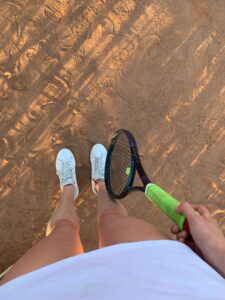
Apart from physics, I went mountain biking with Lorenzo and friends in a nature reserve near Rome, played tennis again (and won!), can now count to ten in Italian (and in Norwegian), and found out that I can’t play table soccer. I’ll stop there for now, but more next week!
April 19: Traffic and other chaos
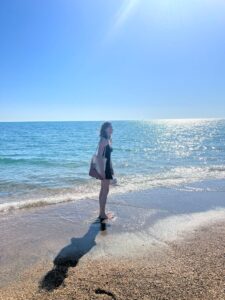
In any case, I was terrified on Roman roads, where stripes on the road seem to have no function and crosswalks are guidelines. Half an hour and three heart attacks later, we were at the tennis court, which was quite nice in the sunshine and among the trees. Besides, I turned out to be the better tennis player, which doesn’t happen often and which I was very pleased with. With the same friend, after playing tennis, I went for an aperitivo at a very nice place in Trastevere.
For dinner afterwards we went to eat something very strange, which is apparently part of the Rome experience. It was some kind of pizza, but shaped like a cone. A pizza ice cream. Pretty tasty. At the end of the evening I was brought back home nicely, and I survived all the car rides.
I also went to the beach. It was already summer in Rome this weekend, the comfortable 26 degrees was very warm even according to the Italians for this time of year. My roommates went with their archaeology friends to Ostia, a coastal town just west of Rome, and I decided to go with them to take my first dip of the year – except for a New Year’s swim. The water was lovely and we had a good time in the sun.
By the way, I hang out with these Norwegian people quite a lot, and get a little taken in by their Norwegian culture. ‘Go to Rome, become Norwegian,’ they tease me all the time. Pff, as if they have so many Italian friends.
Speaking of Italian friends, I went to a ‘PhD seminar’ last Wednesday night. That’s a biweekly event held at Sapienza where PhD students from all branches of physics can give an informal presentation about their research. This time a guy I already knew from my Monte Carlo PhD course happened to give a presentation, about pentaquarks. A comical thing happened halfway through his presentation, when two guys got up to leave before the end. They had to sneak past everyone to get to the door, but one of them tripped and fell sprawling on the floor. That’s what you get!
Apart from this interlude, it was also very nice to hear what other people are doing here for research and afterwards we went for a beer with a group in San Lorenzo. In doing so, I got into the middle of a discussion when one of the guys tried to convince me that red pizza is better than white pizza. Another disagreed whooping, and the whole thing exploded when someone suggested that Californian-style pizzas are pretty tasty, too. I thought this Italian passion for pizza came only from movies, but it turns out to be reality. My tennis friend – who, by the way, also studies physics – could confirm this. Another lesson learned.
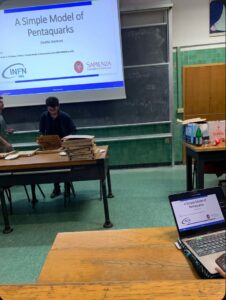
I have been working a lot this week comparing these first results with other simulations of the same process. We want to plot our (differential) neutrino scattering cross sections alongside those from GENIE. GENIE is an existing event generator for neutrino scattering that works with ROOT, which Valentina and I had never done before, so that takes some time. It’s starting to look like something by now, and I think it would be useful to be able to work with ROOT anyway.
And regarding my other project: Marco was at INFN in Frascati most of the week for a workshop, but fortunately he had given me some small-x homework. I read a lot of papers, mimicked calculations and went through code, and thought about how we could implement resummation. On that front it may have been a bit of a boring week, but I hope to have more to say next week because at least we made a plan this morning!”
April 12 First Italian sentences
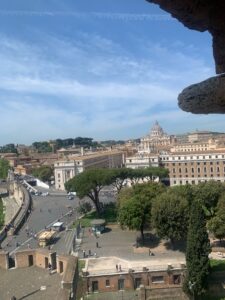
Before coming here, I knew as much as one Italian, Lorenzo, who lives and studies in Rome. Last week I had arranged to meet him for a drink before dinner, which is a very important ritual here.
Apparently the “aperitivo” is something typically Italian, although to my mind it is exactly the same as a drink. I had agreed to meet Lorenzo at a café near the university, the ‘bar dei brutti,’ which means ‘pub of the ugly people.’ Across the street is the “bar dei bella.
In no time, our table was suddenly filled with a dozen other friends of his. And that struck me as typically Italian. So I sat there with ten Italian guys – I was taller than each of them – and they taught me all sorts of things about the Roman language and culture, including my first sentence.
In addition, I found among them both a fellow physics student and a tennis partner, which I was very happy with.
Over the weekend, I also had the opportunity to explore a few things in the neighborhood where I live. Together with my Norwegian roommates Lena and Marita, I went into Trastevere, a nice neighborhood full of bars and fun. We ended up at Trastevere’s most famous pub, “Bar San Calisto,” where it was indeed incredibly nice.
The terrace sits on a little square that was filled with chatting people all evening, like a little festival. The atmosphere was good, as earlier that evening AS Roma had won a derby against Lazio. We happened to have watched that soccer match at home with our neighbors, so we could join in the conversation! Just not in Italian.
In addition, on the physics front, I experienced many fun things over the past few days. For starters, I had my first lecture of a PhD course I am participating in. It is a very happy coincidence that this course on QCD and Monte Carlo coincides exactly with my stay in Rome, and the lecturer was kind enough to let me join last-minute.
There are also weekly seminars organized here à la Nikhef colloquium, the first of which I attended, on sub-GeV Dark Matter. After the seminar, a whole buffet was waiting outside the lecture hall with a wide range of the most delicious pastries. I just took it from there.
I was also able to talk to the seminar speaker later. The nice thing is that my office is the “guest office,” which means that all the guest speakers get to sit there for a few days as well. That earned me some nice dark matter chats again, plus some tips for visiting Florence, where he came from.
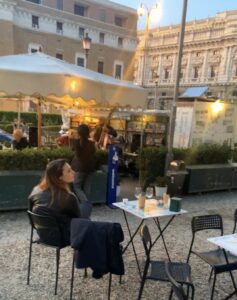
We want to make this Monte Carlo so that it can model neutrino scattering in the (future) Forward Physics Facility (FPF) better than it does now. The neutrinos entering these detectors come from the LHC (for example, from charmed mesons made in the proton-proton collisions), and that involves high energies.
That’s a regime where it’s good to see if you need to add resummation into your calculation for correct predictions. I won’t bore you with the details, but Marco and I are going to see if, in addition to the small-x resummation already done in the determination of the parton distribution functions, we can apply this resummation in the rest of the process. Just to see if that makes a big difference. Nice project!
With this goal in mind, Marco set aside time today to give me a lesson in small-x 101. This certainly proved necessary, and very useful. I hope that in the time I am here I can make some headway with this side project. In addition, of course, I am also very busy with our own project, so that will be a busy time. I like that. You guys will hear next week if I still like it then. ;-)”
April 5: Arriving and getting used.
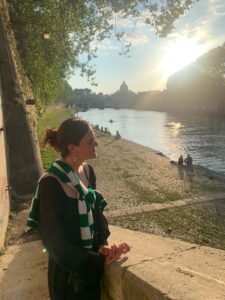
I won the Olga Igonkina Scholarship last December, which allows me to do part of my project abroad. And it just so happens that Juan has a collaborator at the INFN, so I can spend a few months working in the most beautiful city in the world!
Last (Easter) weekend I arrived in Rome – unfortunately just a few hours after the Pope ended his Orbe et Urbi. I live here with three roommates. Lena and Marita, two Norwegian students who happen to be taking a course in Roman archaeology at the Scandinavian Institute here during the exact same period as me, and Abhi, an American who has his own business and travels around Europe with his little laptop.
Abhi already knew a little restaurant where you get a free glass of prosecco and a limoncello upon entering, so at that place we immediately had our first home outing. That promises to be a fun time!
Shocks
My first day at the INFN, which is located on the Sapienza University campus, offered a few cultural shocks. The first thing I noticed when I walked in was that you have to throw coins into the coffee machine instead of holding a card in front of it. And there are purely espressos.
After drinking one of those cups of cordials (not expensive by the way, I was told that espressos are not allowed to be more expensive than a euro anywhere in Italy), I had my first meeting with Marco Bonvini, with whom I will be a guest at the university for the next few months.
I briefly told him what we have been working on for the past few months and showed some results. Then he explained to me a few things about small-x resummation in QCD, the topic he is working on. Fortunately, I had read up on it. He showed me my office some more and then we went to lunch.
Pizza in the park
For lunch, it is apparently normal here for the whole group to get pizza and eat it in a park. This is a tradition that I totally agree with! The park where we were sitting is apparently also regularly visited by all kinds of Nobel Prize winners, Marco told me. They had come across one just last week, whose (Italian) name unfortunately immediately escaped me.
I noticed anyway that everyone in this research group is Italian, which is quite a contrast to Nikhef, where I am used to at least half of the researchers being international. That gives me yet another reason to learn Italian.
I also received very welcome tips on fun things to do in Rome from all sides during lunch. “There is a lot you have to do here!” one of the PhD students pressed me. ‘Yes, a lot of work,’ Marco then said. With a wink.
Get used to it
Today I did find out that I need to get used to the Italian lifestyle. The previous day we had lunch at noon, so now I was ready at the meeting point again at the stroke of midnight, as is always the case in the Nikhef Theory Group. But no one was there. I kept waiting, until 1:30 p.m., and then finally went to get my own lunch.
Later in the afternoon I ran into one of the postdocs in the corridor. “We missed you for lunch! Apparently the Italians are a little less punctual than we are.
Vespa
Later in the afternoon I was meeting up with a Roman friend of mine. He showed up -even half an hour later than planned- on a Vespa from work to the university to spend twenty minutes standing and drinking an espresso with me and then scooting back. In short, all Italian style.
So does she do any physics at all? You may be wondering hopefully. Yes, but not everything fits into one blog! So next week more on neutrinos, resummation, and a Monte Carlo simulation.
Best, Eva”
